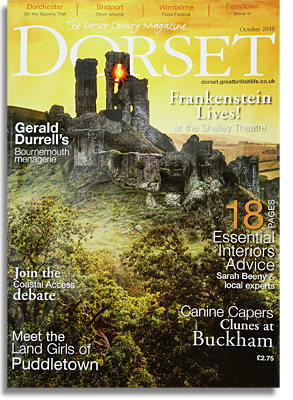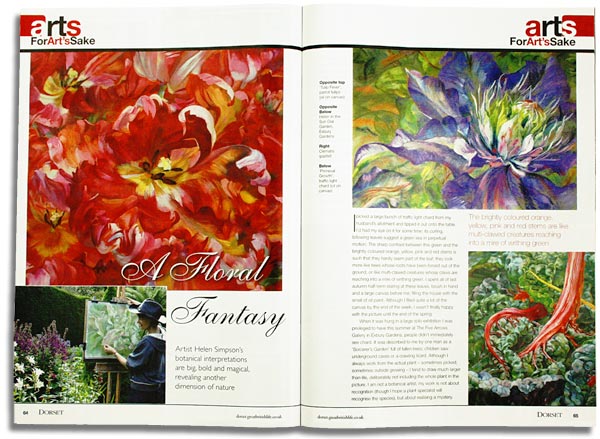| "These are paintings of passion, you can warm yourselves in the volcanic fires of the dancing parrot tulips … and if I were a bumble bee I'd want to plunge myself into her irises to find the honey hidden within." | |
| Nick de Rothschild of Exbury Gardens | |
| "There is often a hint of something slightly other-worldly, slightly spiritual, something one step beyond what you can see. Her pastel In the Beginning conveys this well. Readily identifiable as a botanically correct image of clematis seed-heads, representing both an end and a beginning, it is more than that, calling to mind primitive creatures tossed on the currents of ancient oceans or complex particles whirling through space." Julie Webb from "Down the Garden Path", six page Profile in September 2015 Oxfordshire Limited Edition Magazine | |
| edition.pagesuite-professional.co.uk | |
| "A gentle picture of infinity, without doubt they pull the spirit from the plant and lay it bare." | |
| "The ruffled petals and secret hearts of tulips and iris, taffeta-like daffodil trumpets, crumpled leaves and bright stems of chard, all larger than life, invite you into a landscape that is often overlooked" | |
| Dorset Society, Larger than Life Art, 1 June 2012 | |
"Simpson’s work allows us to return to the pure essence of a garden, to recapture that mood which a plant represents so well. Stillness out of movement, nature just being one with itself, without any need of enhancement whatsoever." |
|
| Style Magazine, Lincolnshire, Flower Power, John Ashwell, June 2002 | |
"Entranced by the hidden world of flowers and vegetables, her paintings give the illusion of actually being inside (or part of?) the iridescent beauty created by nature – the supreme artist" |
|
| Cambridgeshire Town Crier, Secret Life of Plants, Veronica Webb,19 July 1997 | |
"a truly memorable show of an art form so often denounced by those unwilling to look as 'merely illustration'". |
|
| Art Review, Kew Gardens Gallery, Dec/Jan 1996 | |
 Article by Helen Simpson;
Article by Helen Simpson;
published in The Dorset
County magazine “Dorset”,
October 2010
![]() picked a large bunch of Traffic Light Chard from my husband’s allotment and tipped it out onto the table. I’d had my eye on it some time: its curling billowing leaves suggest a green sea in perpetual motion. The sharp contrast between this green and the brightly coloured orange, yellow, pink and red stems is such, that they hardly seem part of the leaf: they look more like trees whose roots have been forced out of the ground, or like multi clawed creatures whose claws are reaching into a mire of writhing green. I spent all of last autumn half term staring at these leaves, brush in hand and a large canvas before me, filling the house with the smell of oil paint. Although I filled quite a lot of the canvas by the end of the week I wasn’t finally happy with the picture until the end of the spring.
picked a large bunch of Traffic Light Chard from my husband’s allotment and tipped it out onto the table. I’d had my eye on it some time: its curling billowing leaves suggest a green sea in perpetual motion. The sharp contrast between this green and the brightly coloured orange, yellow, pink and red stems is such, that they hardly seem part of the leaf: they look more like trees whose roots have been forced out of the ground, or like multi clawed creatures whose claws are reaching into a mire of writhing green. I spent all of last autumn half term staring at these leaves, brush in hand and a large canvas before me, filling the house with the smell of oil paint. Although I filled quite a lot of the canvas by the end of the week I wasn’t finally happy with the picture until the end of the spring.
When it was hung in a large solo exhibition I was privileged to have this summer at The Five Arrows Gallery in Exbury Gardens, people didn’t immediately see chard. It was described to me by one man as a “Sorcerer’s Garden” full of fallen trees; children saw underground caves or a crawling lizard. Although I always work from the actual plant, sometimes picked, sometimes outside growing, I tend to draw much larger than life: deliberately not including the whole plant in the picture. I am not a botanical artist; my work is not about recognition (though I hope a plant specialist will recognise the species), but about realising a mystery.
Thinking back to those very early years of life, when I was not sure whether reality was in my dreams or when awake, I remember waking to my room still in the half dark and seeing a wolf curled up on the chair in my bedroom. I decided to lie dead still in the hope it would not attack, then, as it got light, to my relief the wolf would turn into a pile of clothes. But other mornings I might see a squirrel on the floor, and although I thought it was probably just a shape created by a pile of clothes, I’d cling to the hope it might turn out to be real, and in some mysterious way I had gained a pet squirrel.
Looking at a flower I am aware of three types of mystery. The Mystery as to how nature can produce such a revelation of fragility, colour and perfection. The mystery created by the structure and fall of light within the flower that can suggest a landscape in silent motion, of waves, clouds, hills, valleys, spirals and tunnels; then the mystery of how a crumpled petal or withering leaf can suggest the presence of mysterious forms within that environment. When working on a picture I try not to identify any particular creature, for fear the picture may become contrived and the mystery and fluidity of these shapes lost; but I liked it when I once drew the centre of an orange rose and a child looked at the picture and saw Cinderella’s carriage!
As long as I can remember I have drawn and painted. As a child my mother always encouraged my sisters and I to draw; she herself was an artist and would draw with us. As a treat I would go regularly with her on the early morning train from Canterbury to Rye to the cattle market where we would spend the morning sketching pigs cows and sheep. If I look back at the pictures I did later in my teenage years they reveal an interest in the “overlooked”. My first oil painting was a greatly enlarged version of a blackened brass monkey on my art teacher’s key ring. I spent weeks painting a starling’s nest that came down my chimney, its dusty chicks with their beaks frozen wide; again I drew them large, somehow wanting to draw attention to the pathos of the scene.
Although I was not sure what to do when I finished school, six months spent in India helped me to recognise my need to paint and I resolved to apply for a place at art college on my return. I studied at Banbury College of Art then at the Royal Academy Schools, London. Art College was at first a barren experience; the greyness of the college and London life after always living in the country and more recently India, left me depressed and floundering for direction. It was London flower stalls that mesmerised me into action. I was drawn by the colour and transient life. I wanted nothing but flower in the picture, perhaps a desire to be in a different world. It was Gainsborough’s use of oil paint to describe the way light is seen on the satin dresses of his sitters that encouraged me to use oils to describe the way light seems to change the nature of petals. Pastels being another medium where the opacity of the light colours themselves reflects the light, again suits my interpretation of a flower’s response to light.
It was this response to light that was the focus of my early pictures. However in recent years, although if you look at my pictures they are still very much to do with light, it is the inner transformation that is going on within a plant that now interests me more. Despite an apparent stillness, a plant is involved in a process of continual change and this movement is inherent in its structure. Petals can appear to be seemingly floating on air; they can be stretched in readiness to “take off”; they can seem to be sculpted into swirling channels and billowing shapes by an invisible wind, but there is no wind, just a silent suspension. I would say my style or my flowers, are now more in keeping with the work of Baroque artists, paintings by Titian and especially Rubens, with their billowing forms and swirling compositions, than with the gentry posing in their best frocks in Gainsborough’s paintings.
Two years after leaving the Royal Academy I went to Goldsmiths College where I received an Art Teacher's Certificate. I enjoy teaching, just to paint, even if I could survive financially by it, would make me dangerously introvert and probably loopy! When asked to write this article I was told to mention artistic genes, I believe encouragement to observe and imagine, play a far more important role than genes, so I believe art can be taught. I like to teach part time so I have time to paint. At present I lead art workshops in schools, colleges, art centres or wherever I am invited. Since September 2005 I have been teaching part-time at Castle Court School, Corfe Mullen, Dorset.
Since leaving Art College, mainly as a result of my husband's career, I have moved round between Oxfordshire, London, Cambridgeshire and Lincolnshire. Five years ago we moved to Dorset, deep in the countryside between Dorchester and Sherborne.
Perhaps the most significant event in my exhibiting career was the opportunity to show 30 works in Kew Gardens in 1996-7. Recent solo shows have been at Islington Arts Factory, London; Muriel Barker Gallery, Heritage Centre, Grimsby; Town Mill Galleries, Lyme Regis; Nature in Art, Gloucester and most recently “Move in Closer” a large exhibition of nearly 40 oils and pastels in Exbury Gardens.
![]()